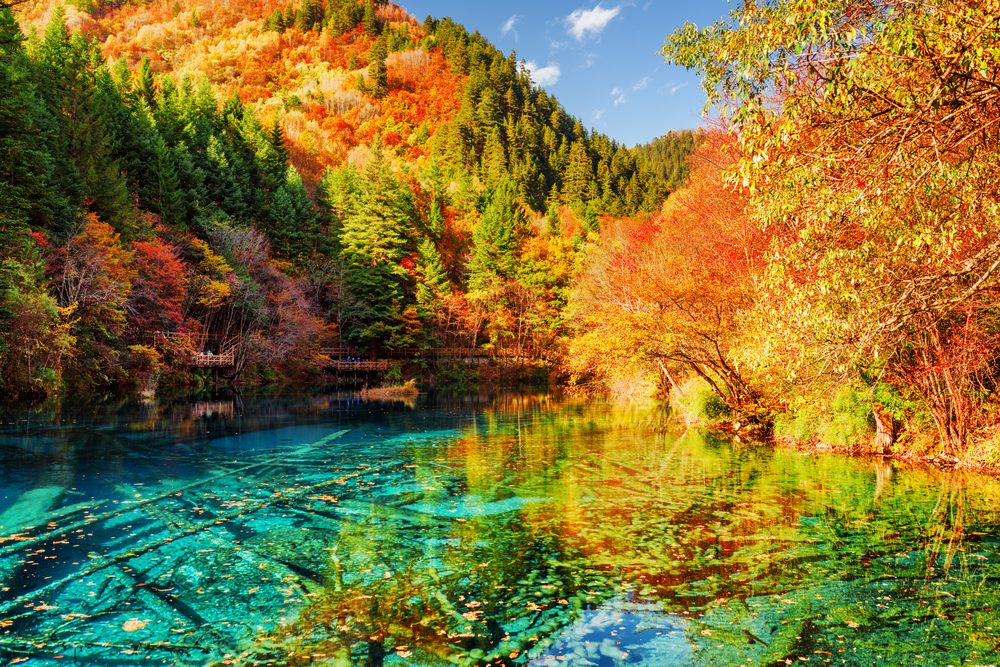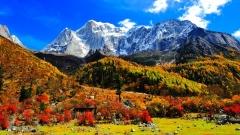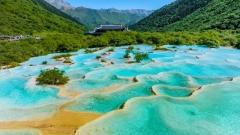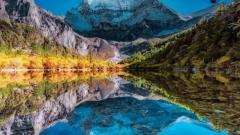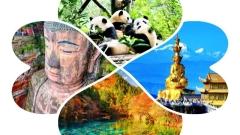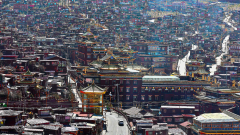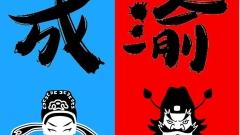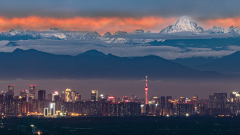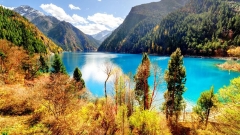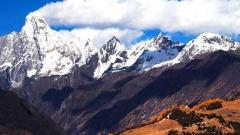High on the Tibetan Plateau in southwestern Sichuan Province, Jiuzhaigou Valley enchants visitors with its turquoise lakes, multi-tiered waterfalls, and lush forests. Generally speaking, the best time to visit Jiuzhaigou National Park is in fall (September to November) or late spring (April to June). Perched between 1,900 and 3,100 meters above sea level, this UNESCO World Heritage site enjoys a moist plateau climate with abundant sunshine, mild summers, and snow-draped peaks in winter.
Jiuzhaigou’s Climate at a Glance
Jiuzhaigou Valley receives an average annual rainfall of 761 mm, but in its cloud forests at 2,700–3,500 m, rainfall climbs to at least 1,000 mm. Monsoon-driven summer rains concentrate between May and October, bringing mild, humid conditions under intermittent cloud cover. The valley’s lakes and rivers swell, showcasing their famed cobalt and emerald hues against dense pine and fir forests. Winters are dry, with cold northerly winds sculpting pristine snowscapes, while spring’s melting snows amplify waterfall flows. Temperatures range from an average low of –1.6 °C in January to highs around 27.6 °C in August, offering a climate that’s as dynamic as its scenery.
Choosing Your Visit Time to Jiuzhaigou
Although Jiuzhaigou is enchanting year‑round, the window from April to November sees the highest tourist influx. Yet within this span, September through November emerges as the sweet spot, when autumn paints the valley in fiery reds, golds, and oranges. Cooler nights add crisp clarity to mountain views, and daytime temperatures hover between 9 °C and 18 °C—ideal for hiking and photography. By planning your trip in this period, you’ll bask in temperate weather, avoid the bulk of summer monsoon downpours, and witness the valley’s most striking seasonal transformation.
Jiuzhaigou Monthly Temperature
Understanding Jiuzhaigou’s monthly averages helps you refine your itinerary. Below is a quick reference:
| Month | Avg. High | Avg. Low |
|---|---|---|
| January | 6.6 °C | –1.6 °C |
| February | 7.9 °C | 0.9 °C |
| March | 15.2 °C | 4.4 °C |
| April | 24.2 °C | 10.6 °C |
| May | 21.8 °C | 11.9 °C |
| June | 24.7 °C | 15.8 °C |
| July | 27.5 °C | 17.0 °C |
| August | 27.6 °C | 17.0 °C |
| September | 22.5 °C | 14.0 °C |
| October | 18.0 °C | 9.9 °C |
| November | 12.5 °C | 4.9 °C |
| December | 7.5 °C | –1.4 °C |
Use these figures to match your tolerance for heat, cold, and rainfall. For example, if you prefer cool but sunny days, target April–June or September–October; if you’re a winter enthusiast, December–February delivers hushed, snow‑blanketed landscapes.
Jiuzhaigou Spring (March–May)
Weather & Scenery
As winter’s grip loosens, Jiuzhaigou awakens. Daytime highs climb to 18 °C, but nights remain chilly—often near freezing—so early spring visitors feel both warmth and a lingering frost. Melting snow swells streams and waterfalls, turning Nuorilang and Arrow Bamboo Lake into thundering spectacles. Budding willows and azaleas lend fresh green and pink hues to the valley floor.
What to Wear
- Layers: sweater plus insulated jacket for mornings and evenings
- Waterproof outer shell: to guard against spring drizzles
- Comfortable walking shoes: sturdy soles for wet paths
- Sun protection: sunglasses and a light hat
Spring’s variable weather rewards flexibility. Bring a mix of warm and breathable clothing, and remain prepared for unexpected showers.
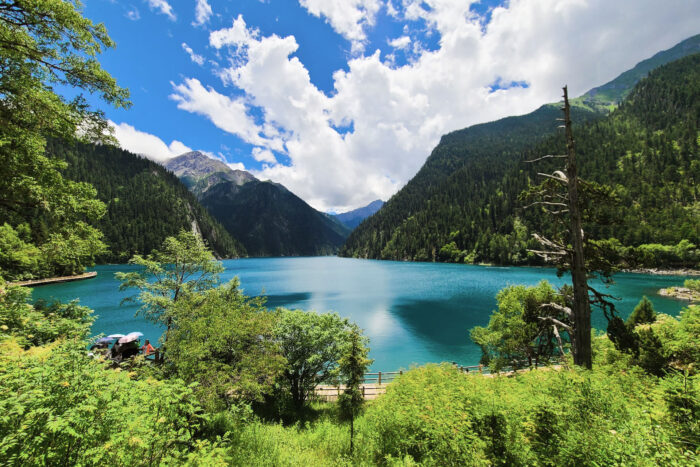
Jiuzhaigou Spring
Jiuzhaigou Summer (June–August)
Weather & Scenery
Summer in Jiuzhaigou is cool and pleasantly sunny, with daily highs around 20–27 °C. Despite being peak season, the temperature remains moderate compared to lower altitudes. Forest canopies are lush, wildflowers bloom in vibrant colors, and the valley hums with life. Morning mists drifting above the lakes create ethereal scenes.
What to Wear
- Light T‑shirts or breathable tops
- Mid‑length trousers or light dresses
- Comfortable hiking or sports shoes
- Sunscreen and UV‑protective sunglasses
Rainfall peaks in July and August. Carry a compact rain jacket or poncho for sudden showers, and pack quick-dry fabrics that wick moisture.
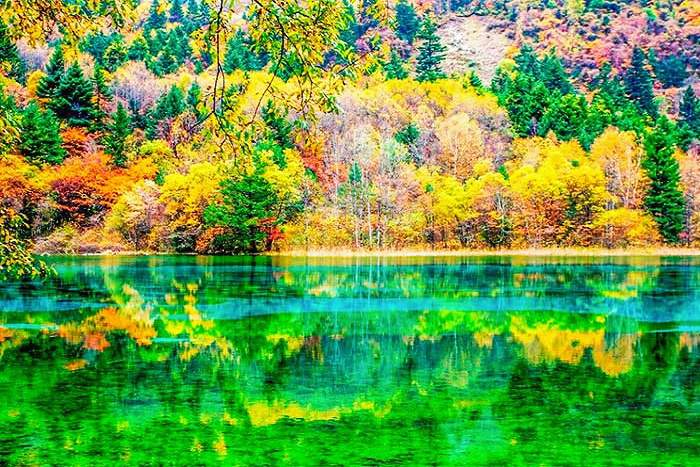
Jiuzhaigou Summer
Jiuzhaigou Autumn (September–November)
Weather & Scenery
Autumn transforms Jiuzhaigou into a painter’s palette. Leaves shift through shades of yellow, orange, and crimson, reflecting off mirror‑like lakes. Daytime highs of 14–22 °C feel crisp yet comfortable, while starry nights offer stunning views of the Milky Way.
What to Wear
- Early autumn (Sept–Oct): long‑sleeve shirt with light jacket
- Late autumn (Nov): sweater and medium‑weight coat
- Comfortable shoes or boots: sturdy enough for fallen leaves
- Layered socks: to keep toes warm on cool mornings
Photographers especially prize this season for the interplay of warm foliage colors against deep blue skies.
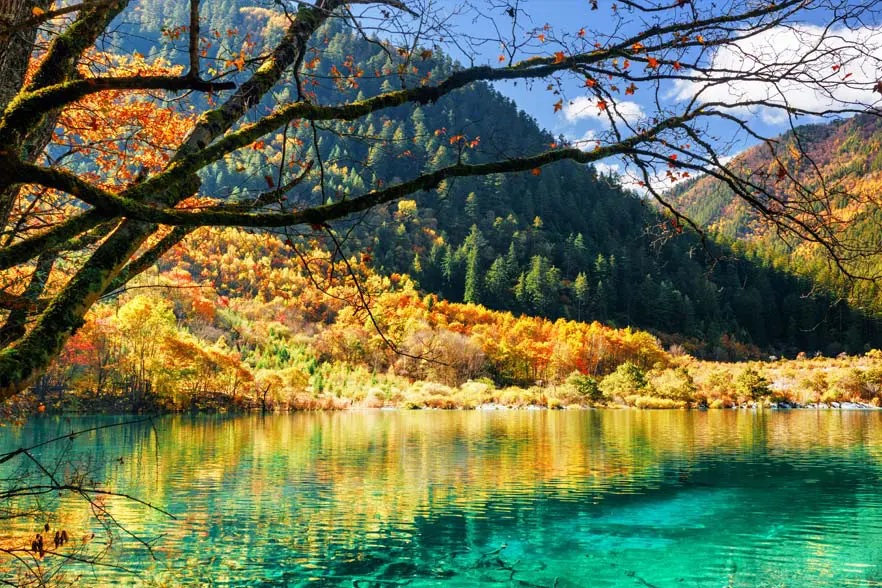
Jiuzhaigou Autumn
Jiuzhaigou Winter (December–February)
Weather & Scenery
Jiuzhaigou’s shoulder season sees fewer crowds but delivers jaw‑dropping snowy vistas. Temperatures swing between –1 °C and 8 °C, and northerly winds create sculpted snowdrifts. Frozen lakes gleam like diamonds under clear winter sunlight, and snow‑laden pines stand silent against the azure canopy.
What to Wear
- Thermal underwear and silk long johns
- Insulated down jacket and thick sweater
- Waterproof, anti‑skid boots for icy paths
- Warm hat, gloves, and scarf
- UV‑blocking sunglasses: snow’s glare can be intense
Winter visits require careful planning for transport, as snow may disrupt mountain roads. But the reward is a serene, pristine landscape bathed in crisp light.
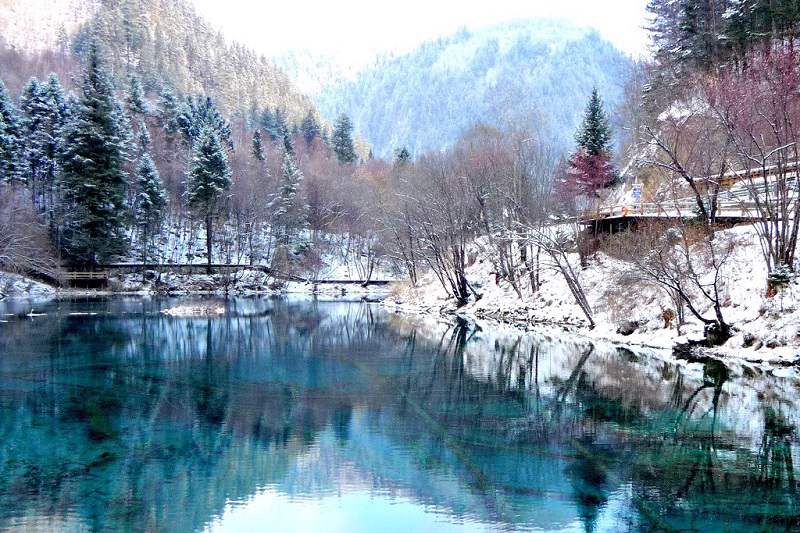
Jiuzhaigou Winter
Planning Your Jiuzhaigou Adventure
Duration & Route
Jiuzhaigou’s iconic “Y‑shaped” valley comprises three main branches—Shuzheng, Rize, and Zechawa—stretching over 50 km. A typical itinerary allocates 1–2 full days:
- Day 1: Enter via Shuzheng Valley. Hike to Nuorilang Waterfall, explore Five‑Flower Lake, and ride the eco‑bus through forested trails.
- Day 2: Choose between Rize Valley’s Mirror Lake and Zechawa Valley’s tranquil Long Lake. Both offer superb vistas, with fewer crowds later in the afternoon.
Nearby Jiuzhaigou
For a deeper immersion in Sichuan’s karst and travertine landscapes, venture 150 km west to Huanglong Valley. Here, terraced pools shimmer in pastel hues, and snow‑capped peaks frame the scene. Nearby Munigou features limestone caves and dense bamboo groves, rounding out a multi‑day expedition.
Jiuzhaigou Travel Tips
- Permits: Reserved through authorized agencies; limited daily entries ensure environmental protection.
- Accommodation: Ranges from guesthouses in Zhangzha Town (gateway to the park) to eco‑lodges within the valley. Book well in advance during peak season.
- Altitude Considerations: While Jiuzhaigou tops at 3,100 m, many visitors experience minimal discomfort. Still, acclimatize in Chengdu or Chengdu’s suburbs before ascending.
- Transportation: Regular shuttle buses link Chengdu, Langzhong, and Jiuzhaigou. Private transfers and tour‑operator vehicles offer door‑to‑door convenience.
Experience Jiuzhaigou with China Dragon Travel
At China Dragon Travel, we specialize in crafting personalized Sichuan and Tibet journeys that reveal China’s most spectacular landscapes. From securing park permits and comfortable accommodation in Zhangzha to arranging guided treks through Jiuzhaigou and Huanglong, our expert team ensures every detail is covered. Contact China Dragon Travel today to design your unforgettable Jiuzhaigou adventure.
Recommended Jiuzhaigou Tours:



